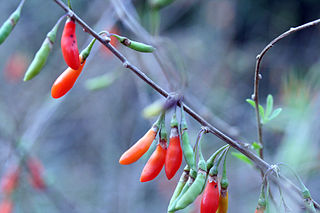
Streptomyces is the largest genus of Actinomycetota and the type genus of the family Streptomycetaceae. Over 500 species of Streptomyces bacteria have been described. As with the other Actinomycetota, streptomycetes are gram-positive, and have genomes with high GC content. Found predominantly in soil and decaying vegetation, most streptomycetes produce spores, and are noted for their distinct "earthy" odor that results from production of a volatile metabolite, geosmin.

Lycium is a genus of flowering plants in the nightshade family, Solanaceae. The genus has a disjunct distribution around the globe, with species occurring on most continents in temperate and subtropical regions. South America has the most species, followed by North America and southern Africa. There are several scattered across Europe and Asia, and one is native to Australia. Common English names for plants of this genus include box-thorn and desert-thorn.

Lycium barbarum is a shrub native to China, with present-day range across Asia and southeast Europe. It is one of two species of boxthorn in the family Solanaceae from which the goji berry or wolfberry is harvested, the other being Lycium chinense.

Lycium chinense is one of two species of boxthorn shrub in the family Solanaceae. Along with Lycium barbarum, it produces the goji berry ("wolfberry"). Two varieties are recognized, L. chinense var. chinense and L. chinense var. potaninii. It is also known as Chinese boxthorn, Chinese matrimony-vine, Chinese teaplant, Chinese wolfberry, wolfberry, and Chinese desert-thorn.

Streptomyces griseus is a species of bacteria in the genus Streptomyces commonly found in soil. A few strains have been also reported from deep-sea sediments. It is a Gram-positive bacterium with high GC content. Along with most other streptomycetes, S. griseus strains are well known producers of antibiotics and other such commercially significant secondary metabolites. These strains are known to be producers of 32 different structural types of bioactive compounds. Streptomycin, the first antibiotic ever reported from a bacterium, comes from strains of S. griseus. Recently, the whole genome sequence of one of its strains had been completed.

The Karakoram-West Tibetan Plateau alpine steppe is a montane grasslands and shrublands ecoregion found in parts of Pakistan, China, Afghanistan, and India.
Streptomyces scabies or Streptomyces scabiei is a streptomycete bacterium species found in soils around the world. Unlike most of the 500 or so Streptomyces species it is a plant pathogen causing corky lesions to form on tuber and root crops as well as decreasing the growth of seedlings. Along with other closely related species it causes the potato disease common scab, which is an economically important disease in many potato growing areas. It was first described in 1892, being classified as a fungus, before being renamed in 1914 and again in 1948. Several other species of Streptomyces cause similar diseases to S. scabies but other, more closely related species, do not.
Streptomyces albus is a bacterial species from which the pseudodisaccharide aminoglycoside salbostatin was isolated. S. albus is known to produce white aerial mycelium.
Coleophora lycii is a moth of the family Coleophoridae. It is found in Turkestan and Uzbekistan.
Coleophora neolycii is a moth of the family Coleophoridae which is endemic to China (Ningxia).

Streptomyces hygroscopicus is a bacterial species in the genus Streptomyces. It was first described by Hans Laurits Jensen in 1931.
Scrobipalpula lycii is a moth in the family Gelechiidae. It was described by Powell and Povolný in 2001. It is found in North America, where it has been recorded from California.
Streptomyces bacillaris is a bacterium species from the genus of Streptomyces which has been isolated from forest soil in Oregon in the United States.
Streptomyces cinnamoneus is a bacterium species from the genus of Streptomyces which has been isolated from soil in Japan. Streptomyces cinnamoneus produces duramycin A, duramycin B, duramycin C, carbomycin, cinnomycin and fungichromin.
Streptomyces guanduensis is an acidophilic bacterium species from the genus of Streptomyces which has been isolated from pine forest soil from Guandu in the Yunnan Province in China.
Streptomyces lunaelactis is a bacterium species from the genus of Streptomyces which has been isolated from moonmilk speleothem from a cave in Comblain-au-Pont in Belgium. Streptomyces lunaelactis produces ferroverdin A
Streptomyces rhizophilus is a bacterium species from the genus of Streptomyces which has been isolated from rhizosphere soil from the plant Sasa borealis.
Streptomyces rubidus is an acidophilic bacterium species from the genus of Streptomyces which has been isolated from soil from a pine forest in Yanglin in the Yunnan province in China.
Streptomyces zinciresistens is a filamentous bacterium species from the genus of Streptomyces which has been isolated from a copper and zinc mine in the Shaanxi province in China. Streptomyces zinciresistens is resistant against zinc.
Streptomyces lasalocidi is a bacterium species from the genus of Streptomyces which has been isolated from soil from the Hyde Park in Massachusetts.






